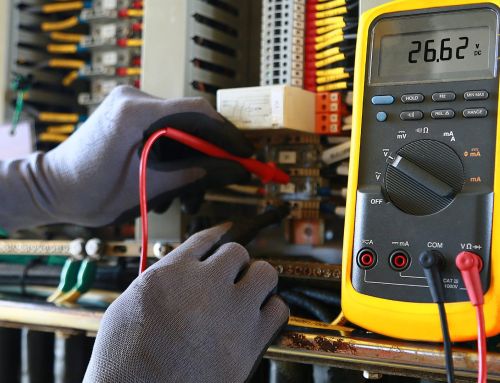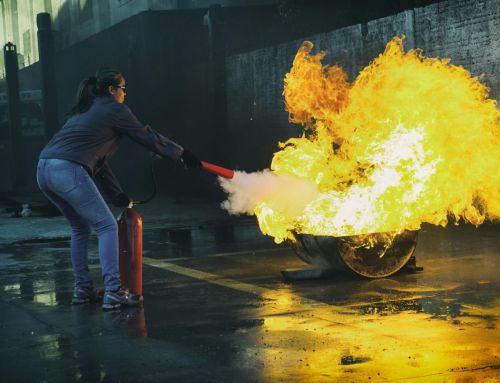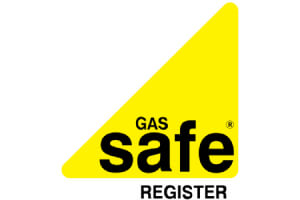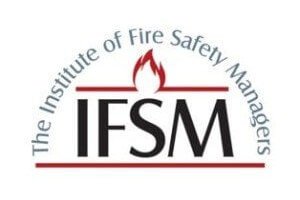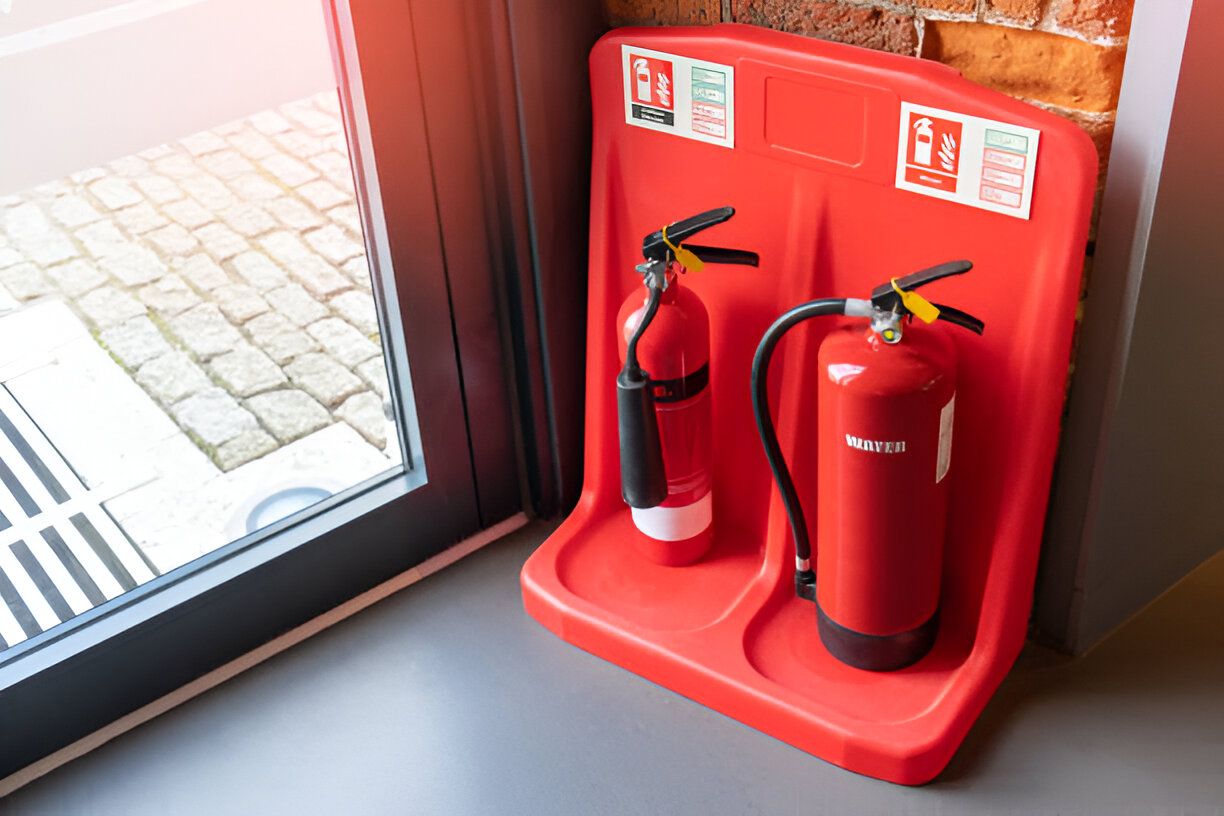
In the realm of fire safety within the United Kingdom, the adherence to stringent fire extinguisher regulations, as dictated by the Regulatory Reform (Fire Safety) Order 2005, plays a pivotal role in ensuring the safety and preparedness of both public and private establishments. These regulations, which require the correct selection, placement, and maintenance of fire extinguishers, are grounded in addressing specific types of fire hazards appropriately. As we explore the implications of these rules further, one must consider how current compliance levels impact overall safety and what steps can be taken to enhance fire safety protocols effectively. Let’s understand UK Fire Extinguisher Regulations.
What Are Fire Extinguisher Regulations?
Fire extinguisher regulations in the UK are comprehensive guidelines mandated to ensure that public and private buildings are equipped with appropriate fire-fighting tools to handle emergencies effectively.
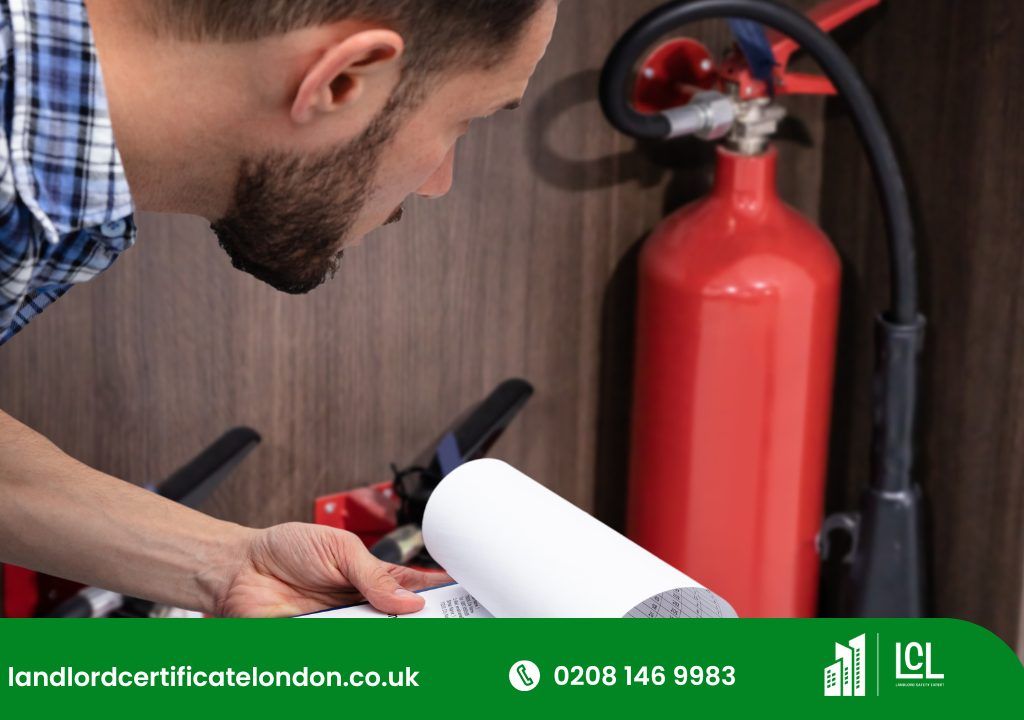
These regulations are deeply rooted in the historical evolution of fire safety, where significant innovations have shaped today’s standards and practices. The Regulatory Reform (Fire Safety) Order 2005 underscores the necessity of installing and maintaining adequate fire extinguishers tailored to the specific risks present in a building.
These guidelines stipulate that the selection of fire extinguishers must consider the classes of fire that might occur, which directly ties into the advancements in fire extinguisher technology. Innovations such as multipurpose dry powder and wet chemical extinguishers cater to complex, modern-day fire risks in kitchens and electrical areas, reflecting the progression from the simple water and foam extinguishers of the past.
Moreover, the regulatory framework ensures that these devices are not only present but are also accessible, properly installed, and regularly inspected.
This adherence to both historical wisdom and contemporary innovation in fire safety equips residents and workers with the tools and knowledge necessary to effectively mitigate the risks of fire, thereby enhancing overall safety in various environments.
Why Are These Regulations Important?
Understanding the significance of fire extinguisher regulations is crucial for ensuring public safety and legal compliance in buildings across the UK. These regulations are integral to maintaining a safe environment and minimizing the risks associated with fire incidents. They provide a structured approach to fire safety that is critical for the protection of life and property.
Here are three key reasons why these regulations are important:
- Risk Mitigation:
- Ensures that appropriate fire extinguishers are available and accessible in case of fire, significantly reducing potential damage and injury.
- Requires regular fire risk assessments to identify and address specific hazards in different building types and usage scenarios.
- Legal Compliance:
- Adherence to fire safety regulations, including the provision and maintenance of fire extinguishers, is legally mandatory under the Regulatory Reform (Fire Safety) Order 2005.
- Non-compliance can result in severe penalties, including fines and legal actions, underscoring the importance of following these guidelines.
- Public Safety Enhancement:
- Promotes awareness and readiness among occupants, ensuring everyone understands how to use fire extinguishers effectively during emergencies.
- Contributes to overall public safety by equipping buildings with the necessary tools to combat initial fire outbreaks, preventing escalation.
These elements collectively emphasize the vital role of fire extinguisher regulations in safeguarding individuals and properties.
Types of Fire Extinguishers
Diversity in extinguishing agents is crucial for effective fire management across various environments. The UK Fire Safety Regulations identify several fire extinguisher classifications, each designed for different types of fires—classed by the materials involved. This specificity is vital in ensuring that fires are controlled and extinguished safely and efficiently.

Water extinguishers are optimal for Class A fires, which involve organic materials such as wood and paper. Foam extinguishers serve well in tackling both Class A and Class B fires, the latter involving flammable liquids.
Carbon dioxide (CO2) extinguishers are preferred for electrical fires due to their non-damaging and non-conductive properties, essential in environments with electronic equipment.
Dry powder extinguishers are versatile, covering Class A, B, and C fires, which include gases. However, their residue can be harmful to electronics and machinery, thus requiring careful consideration of application.
Conversely, wet chemical extinguishers are specifically formulated for Class F fires, typically involving cooking oils and fats, prevalent in kitchen settings.
Understanding these extinguisher types and their appropriate uses is fundamental. The selection of the correct extinguishing agents, in compliance with legal standards, ensures that risks are minimally escalated during fire emergencies.
Installation Guidelines
Effective installation of fire extinguishers is crucial for ensuring rapid and efficient response during a fire emergency. Installation standards and correct fire extinguisher placement are mandated to maximize accessibility and functionality. These guidelines adhere strictly to the UK’s regulatory framework, ensuring that fire extinguishers are both visible and accessible in the event of a fire.
Installation Guidelines:
- Visibility and Accessibility:
- Fire extinguishers must be installed at a height of 1 meter from the floor to the handle for those weighing less than 4 kilograms, and at 1.5 meters for heavier units. This ensures ease of access for all individuals, including those with disabilities.
- Strategic Placement:
- Extinguishers should be placed near room exits, hallways, and stairways, and in locations where fires are likely to occur, such as kitchens and boiler rooms. It is essential that they are free from obstructions and clearly visible from a distance.
- Compliance with Installation Standards:
- Installations must comply with BS 5306-8:2012 standards, which provide detailed guidelines on the positioning and installation of fire extinguishers. Regular audits and checks should be conducted to ensure ongoing compliance with these standards.
Each installation point must be marked with appropriate signage and instructions for use should be displayed to ensure an effective response in an emergency.
Compliance and Penalties
Non-compliance with the UK’s fire extinguisher regulations under the Regulatory Reform (Fire Safety) Order 2005 can lead to severe penalties, including fines and imprisonment.
The enforcement measures are designed to ensure that all non-domestic premises adhere strictly to fire safety standards, which include the proper provision, installation, and maintenance of fire extinguishers.
Failure to comply can result in non-compliance consequences that are severe to emphasize the importance of fire safety. The responsible person faces significant fines that can escalate depending on the severity and frequency of the breaches.
In extreme cases, where negligence leads to life-threatening situations, criminal charges can be brought, potentially resulting in imprisonment.
It is crucial for businesses and property owners to understand that these regulations are not mere guidelines but mandatory requirements enforced by local fire services.
Regular audits and inspections are conducted to ensure compliance. Non-compliance is often met with immediate corrective directives and, if not promptly addressed, may lead to legal action.
Hence, maintaining an up-to-date knowledge of fire safety regulations and ensuring compliance is imperative for safety and legal protection.
Maintenance Requirements
Maintaining fire extinguishers in accordance with UK regulations is essential for ensuring their functionality and effectiveness in emergency situations. Under the Regulatory Reform (Fire Safety) Order 2005, all fire extinguishers on premises must undergo regular maintenance. This not only ensures readiness in case of a fire but also complies with legal standards that can affect insurance and liability.
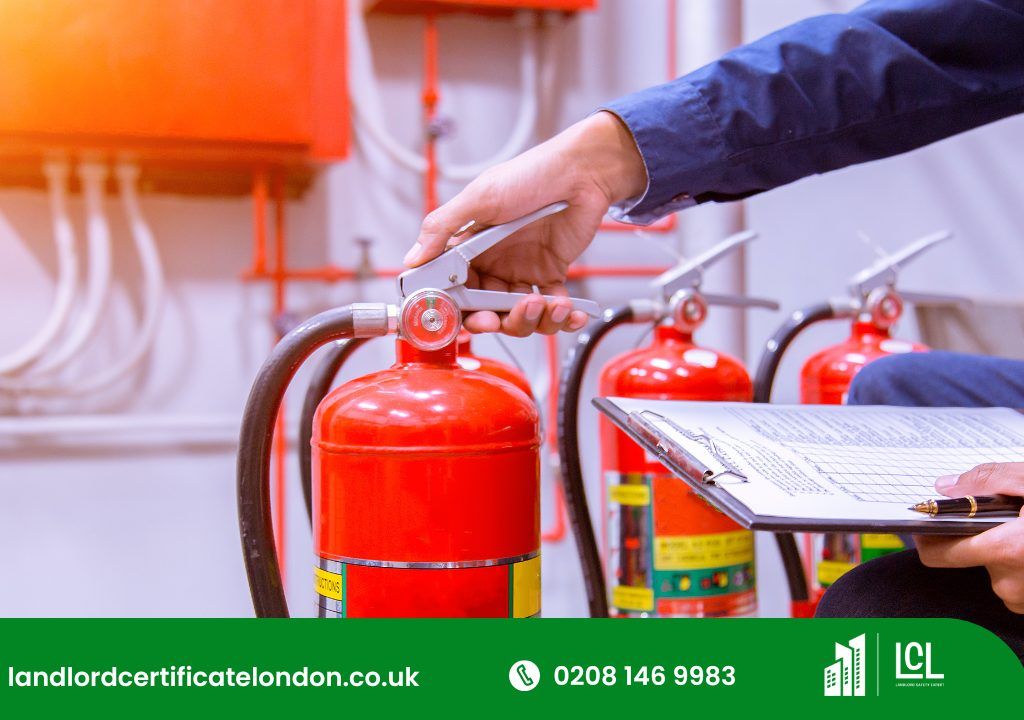
Key maintenance requirements include:
- Regular Inspections and Servicing:
- Monthly visual inspections by the designated safety officer to check for damages, obstructions, or pressure loss.
- Annual servicing by a certified technician in line with BS 5306 standards, covering physical state, operational efficacy, and correct placement.
- Recording and Documentation:
- Detailed records of all maintenance activities must be maintained. This includes dates of inspections, issues found, corrective actions taken, and the signatures of the individuals involved.
- These records should be readily available for review during safety audits or inspections by fire safety authorities.
- Replacement and Disposal:
- Fire extinguishers must be replaced or undergo extended servicing every 5-10 years, depending on the type and manufacturer guidelines.
- Proper disposal procedures must be followed for expired or damaged units to ensure environmental safety and compliance.
Adhering to these guidelines ensures that fire extinguishers are ready to function effectively, safeguarding both property and lives.
Choosing the Right Fire Extinguisher
Selecting the appropriate fire extinguisher for your premises involves understanding the specific fire risks associated with the environment. Effective fire extinguisher selection hinges on evaluating the materials and processes within the space that could ignite and fuel a fire.
For instance, premises that handle organic materials like paper, wood, or textiles require a water-based extinguisher, optimal for suppressing Class A fires. In contrast, environments with flammable liquids or gases would benefit from foam or CO2 extinguishers, which are effective against Class B and electrical fires, respectively.
Moreover, the size and layout of the premises dictate the number and capacity of extinguishers needed. A thorough fire risk assessment will help in determining these factors, ensuring that extinguisher effectiveness is maximized in the event of an emergency.
It’s crucial to equip your space with extinguishers that not only match the types of potential fires but are also sufficient in number and size to cover the area effectively.
Compliance with UK fire safety regulations mandates that fire extinguisher selection is not merely a matter of preference but of strict adherence to safety standards designed to mitigate specific hazards.
Therefore, consulting with a certified fire safety expert is advisable to ensure your choices align with legal and practical requirements.
Residential Safety Measures
In the realm of residential fire safety, stringent measures are essential to ensure the well-being of occupants and the structural integrity of homes. Addressing residential preparedness and fire safety education effectively minimizes risks and enhances emergency response capabilities within private living spaces.
Key aspects of residential safety measures include:
- Educational Initiatives: Implementing comprehensive fire safety education programs for all age groups ensures that residents are well-informed about potential fire hazards and the correct use of fire extinguishers.
It is crucial that educational materials cover the development of escape plans and the importance of regular fire drills.
- Installation of Safety Equipment: Homes should be equipped with appropriately rated fire extinguishers, smoke detectors, and fire blankets.
The placement of these devices should be strategic to facilitate quick access in the event of a fire, with clear instructions provided for their use.
- Regular Maintenance and Inspections: Regular checks and maintenance of fire safety equipment are mandatory to ensure they function properly when needed.
This includes annual servicing of fire extinguishers and testing smoke alarms to confirm operational readiness.
Through adherence to these guidelines, residential environments can achieve a high level of safety, effectively reducing the likelihood and impact of fire-related incidents.
Frequently Asked Questions
Can a Business Opt-Out of Fire Extinguisher Requirements?
Businesses cannot opt out of fire safety compliance, including extinguisher requirements, as adherence to these regulations is mandatory to ensure safety and minimize fire-related risks, without any exemptions provided for business entities.
How Do Seasonal Properties Handle Fire Extinguisher Regulations?
Seasonal properties must adhere to stringent fire safety norms, ensuring regular seasonal inspections and diligent property management to maintain compliance. These measures safeguard occupants and property, emphasizing year-round preparedness and regulatory adherence.
Are Fire Extinguishers Mandatory in All Vehicles?
Fire extinguishers are not universally mandatory in all vehicles; however, their inclusion enhances vehicle safety, particularly with suitable extinguisher types for potential vehicle fires. Compliance varies by jurisdiction and vehicle type.
Do Historical Buildings Have Different Extinguisher Regulations?
Historical buildings require tailored fire safety compliance to preserve structural integrity while ensuring public safety. Regulations mandate appropriate extinguishers, considering architectural preservation and modern safety standards, to balance historical preservation with effective fire response.
Is Fire Extinguisher Training Mandatory for All Employees?
Fire extinguisher training for all employees is essential to ensure compliance with fire safety standards and uphold employee responsibilities in emergency situations, fostering a prepared and knowledgeable workforce equipped to handle potential fire incidents.
Conclusion
In conclusion, adherence to the UK Fire Extinguisher Regulations is essential for ensuring safety in both public and private buildings. By mandating specific guidelines for the installation, maintenance, and usage of fire extinguishers, these regulations play a critical role in minimizing fire-related risks. Compliance not only fulfills legal obligations but also enhances emergency preparedness, thereby safeguarding lives and property. It is imperative for building owners and occupants to understand and implement these standards diligently.
About the Author: LandlordCertificate
Related Posts
Get Social
Recent Posts
- Fire Risk Assessment Review as a Driver of Stronger Safety Control
- Comprehensive EICR London Services for Every Property
- System Planning for Large Buildings with Fire Alarm Installation
- Fire Service Fire Risk Assessment for Stronger Safety Management
- Electrical Risk Clarity Improved Through an EICR Report


